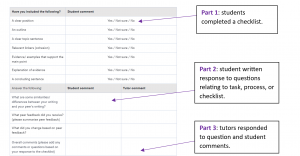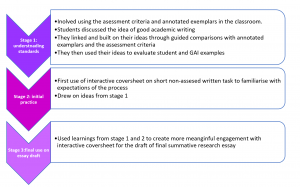Increasing dialogue but not workload: developing effective dialogic feedback processes through using interactive coversheets
 Craig Davis is a Senior Language Tutor and Academic Leader at the University Centre for Academic English (UCAE) within SALC. He teaches and coordinates a range of courses providing academic language support, primarily for international students. As the assessment coordinator for UCAE, he leads the development and delivery of assessments for pre-sessional programmes. An advocate for assessment for learning, he is proactive in enhancing student and tutor assessment and feedback literacy within the programmes he is involved in. He continually explores ways to make assessment processes more meaningful and student-centered and is keen to engage in discussions on this topic.
Craig Davis is a Senior Language Tutor and Academic Leader at the University Centre for Academic English (UCAE) within SALC. He teaches and coordinates a range of courses providing academic language support, primarily for international students. As the assessment coordinator for UCAE, he leads the development and delivery of assessments for pre-sessional programmes. An advocate for assessment for learning, he is proactive in enhancing student and tutor assessment and feedback literacy within the programmes he is involved in. He continually explores ways to make assessment processes more meaningful and student-centered and is keen to engage in discussions on this topic.
NSS data consistently seems to show ‘assessment and feedback’ as being the lowest rated theme in terms of student satisfaction. I want to share an approach taken on our large scale pre-sessional programmes at UCAE that aims to address this by creating a more meaningful and student-centred feedback process.
Interactive coversheets and dialogic feedback processes
One argument for addressing dissatisfaction around feedback is to increase student-tutor dialogue, and I think many would agree this is a sensible approach, but may not have the time or resource to build in more dialogue into existing structures.
Aware of this key constraint, the most resource effective method for us to increase student led dialogue at scale was by introducing interactive coversheets. These are a form of coversheet submitted with a piece of work that aims to elicit some kind of judgement, comment, or request from the student. I then asked tutors to write their feedback on the same coversheet, either by responding to student comments or answering the same questions that guided the student response – hopefully resulting in student led dialogue, and student driven feedback.
A look through literature on the use of interactive coversheets will show a number of potential challenges when it comes to meaningful student engagement:
- perceived lack of expertise
- not knowing what to ask for feedback on
- a lack of understanding around standards/expectations, or simply not valuing the task.
To mitigate against these, a 3-part interactive coversheet was developed and introduced as part of a 3-stage process.
The 3-part interactive coversheet
There were always 3 parts to the interactive coversheets used on our pre-sessionals:
Example of an interactive coversheet submitted with a non-assessed short written task

Part 1: checklist
This is a relatively cognitive load light task and acted as a good gateway to the following questions. It provided a good starting point and gives an early sense of completion in attempt to foster further engagement.
Part 2: student comments
These gave the opportunity for students to reflect on and explain anything from part 1 that they considered worthy of attention; or make explicit anything relevant to the process. In this example, students were asked to reflect on a peer feedback task. These comments acted as a feedback request by proxy and guided tutor comments.
Part 3: tutor comments
After trialling on previous courses, I realised it important to have space for a tutor response to enable comparison i.e. side by side. This made dialogue clear for both student and tutor. Tutors were supported in using student comments to guide their own feedback, thus creating richer dialogue.
n.b – feedback provided on the coversheets wasn’t in addition to any other form of feedback. Tutors were previously asked to write overall comments on Turnitin – the coversheets simply replaced this approach.
The 3-stage process
To enable meanginful engagement with the interactive coversheets, they were embedded within a 3-stage process:

This process ensured that by the time students reached stage 3, arguably the most important stage in relation to their final grade, they had already become familiar with the process and started to build an awareness of standards. This ensured more meaningful dialogue around the final draft. It also allowed linking with previous dialogues.
Feedback & wider application
Feedback was overwhelmingly positive from students and tutors.
Students generally reported that they were:
- more confident in identifying mistakes in their work
- more confident in giving themselves feedback
- more confident in engaging with assessment criteria and feedback generally
Interestingly, students were also reporting lower levels of confidence with peer feedback when compared to self, suggesting that this could be a good way to scaffold peer feedback by building confidence and familiarity with expectations.
Tutors generally reported that use of the coversheets:
- saved time in many cases as it provided a specific feedback focus for each task
- developed student awareness of strengths/weaknesses and a good way to scaffold self-assessment
- led to more meaningful reflection and more productive one to one tutorials
Despite the positive feedback, improvements can still be made to this process. Engagement wasn’t equal and some students chose not to engage or only did so minimally. Some tutors also suggested that the depth of response from the student had an impact on how long it took to add feedback, meaning time savings weren’t apparent at first glance for all. However, this process was very well received overall, and went a long way in addressing some of the usual challenges with managing feedback – And this was only the 1st iteration.
UCAE pre-sessionals are short and intense; we only have 6 or 10 weeks with our students, and as such, it can be a challenge in shifting attitudes and beliefs around learning in such a short time. However, I firmly believe that if we continue to support our students – not only in developing these skills but also in recognising the value of their own voice. If these skills are further nurtured at faculty level through continued support and opportunity, our students will continue to grow into empowered, self-regulate learners who can thrive both during their time at UoM and beyond.
This approach was also shared at the Advance HE Assessment & Feedback Symposium 2024. Please access my slides here.
I’d very interested in hearing from anyone who has tried something similar or who would like to know more. More examples of interactive coversheets used plus activities used in the 3-stage process will be shared with the Assessment Toolkit.







0 Comments